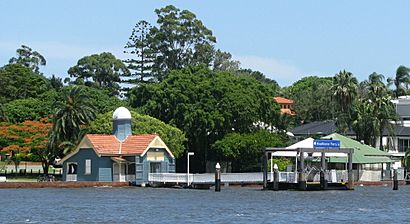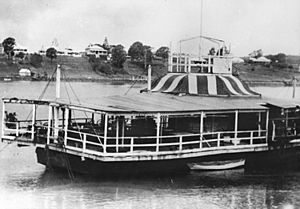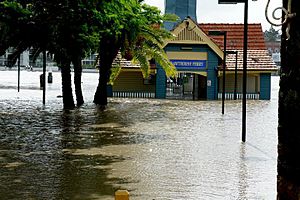Hawthorne ferry wharf facts for kids
Quick facts for kids
Hawthorne
|
|||||||||||
|---|---|---|---|---|---|---|---|---|---|---|---|
 |
|||||||||||
| Location | Gordon Street, Hawthorne | ||||||||||
| Coordinates | 27°27′42″S 153°03′13″E / 27.4616°S 153.0535°E | ||||||||||
| Owned by | Brisbane City Council | ||||||||||
| Operated by | RiverCity Ferries | ||||||||||
| Platforms | 1 | ||||||||||
| Construction | |||||||||||
| Disabled access | Yes | ||||||||||
| Other information | |||||||||||
| Fare zone | go card 1 | ||||||||||
| History | |||||||||||
| Opened | 1925 | ||||||||||
| Services | |||||||||||
|
|||||||||||
| Hawthorne ferry wharf | |
|---|---|

Hawthorne ferry wharf, 1913
|
|
| Location | Gordon Street, Hawthorne, Queensland, Australia |
| Design period | 1919 - 1930s (interwar period) |
| Built | 1924 - 1925 |
| Architect | George Henry Male Addison & Son |
| Architectural style(s) | Arts & Crafts |
| Official name: Hawthorne Ferry Terminal & Hardcastle Park | |
| Type | state heritage (landscape, built) |
| Designated | 24 January 2003 |
| Reference no. | 602212 |
| Significant period | 1920s (historical) 1925-ongoing (social) |
| Significant components | archway, jetty/pier, waiting shed, pontoon, trees/plantings, views from, gate - entrance, bench/seat, views to, tower - clock, park / green space, seating, shed - shelter, wall/s - retaining |
| Lua error in Module:Location_map at line 420: attempt to index field 'wikibase' (a nil value). | |
The Hawthorne ferry wharf is a special old ferry stop on the Brisbane River in Hawthorne, Queensland, Australia. It's a place where people catch RiverCity Ferries' CityCat boats to travel across the river. This wharf is considered a very important historical site. It was added to the Queensland Heritage Register in 2003 because of its history and design.
Contents
The History of Hawthorne Ferry Wharf
The Hawthorne ferry wharf was built in 1925. The Brisbane City Council built it using a design that was first made for the Balmoral Shire Council. This council used to manage many ferry routes across the Brisbane River.
Ferries have been a super important way to travel in Brisbane for a long time. Even when Brisbane was a convict settlement, people used simple boats called "punts" to cross the river. The river winds and loops through the city, so crossing it by ferry saved a lot of travel time.
The first bridge in Brisbane was built in 1862, connecting the city to South Brisbane. But for many years, there weren't many other bridges. Public transport was limited, and most people didn't have their own cars until after World War II. This meant ferries were vital for people to get to work, shops, and entertainment every day. Local councils were in charge of these important ferry services.
In 1844, the first regular ferry service started between Customs House and Kangaroo Point. By 1850, rowing boat ferries were running at Bulimba. In 1888, the areas of Bulimba and Hawthorne became part of the Balmoral Divisional Board's responsibility. This board later became the Balmoral Shire Council in 1901. They managed ferries in areas like Apollo, Bulimba, Norman Park, and Hawthorne.
In 1921, the Balmoral council decided to build a better waiting area for passengers at Bulimba. They hired a famous architecture firm, George Henry Male Addison & Son, to design it in 1922. The design was likely by George Frederick Addison, as his father had passed away. The high quality of the building showed how important the ferry was to the community.
In 1924, the Balmoral Council decided to build a second ferry house at Hawthorne. It was a slightly changed version of the Bulimba design. The new design made the building look like a cross from above. This made the two ferry terminals look like a matching pair from the river.
In 1925, all the different councils in Brisbane joined together to form the Brisbane City Council. This new council took over building and managing ferry terminals. The contract for the new waiting shed at Hawthorne was given in October 1925. The Hawthorne and Bulimba ferry houses are much more decorative than other ferry buildings on the Brisbane River, most of which were built much later.
Around 1939, the area near the Hawthorne ferry terminal was known as Hawthorne Ferry Park. Local residents asked the Brisbane City Council to rename it after SWB Hardcastle. He was a well-known and respected resident of Hawthorne. The residents even offered to pay for a special entrance arch if the Council provided the stone. This arch, bearing the park's name, was then built at the entrance.
The ferry terminal still works as a ferry stop today and looks very much like it did originally. Some changes were made to the tower, like removing the clock faces.
The wharf had only minor damage during the big Brisbane floods in January 2011. It was fixed and reopened on 14 February 2011.
What the Hawthorne Ferry Wharf Looks Like
The Hawthorne Ferry House is located on the bank of the Brisbane River. It sits in Hardcastle Park, directly across from the old wool stores at Teneriffe. You can reach it from the river by a floating platform called a pontoon. From the land, a path leads to a covered waiting area.
Hardcastle Park is a flat, open area along the riverbank on Gordon Street. It has a few trees, so you can easily see the ferry house from the road. To enter the park, you walk through an archway. This arch has two stone pillars supporting a metal arch that spells out the park's name. A path with special stone edges, made from Brisbane tuff, leads from the entrance to the ferry house.
The ferry house is made of timber and stands on stumps. It has timber weatherboards on the outside. From above, it looks like a cross shape. The roof is made of terracotta tiles, and where the roof sections meet, there's a small tower with a dome-like top called a cupola. This cupola is covered in flat metal sheets. The ends of the roof (called gables) have decorative timberwork and pairs of support pieces called brackets.
The sides of the building that face the river and the land entrance are open. They have timber railings and corner posts. On the north and south sides, there are small rooms on either side of the main walkway. Inside, the floor and ceiling are made of timber. There are also timber bench seats along the walls for people to sit on while they wait.
Why Hawthorne Ferry Terminal is Important
The Hawthorne Ferry Terminal and Hardcastle Park were listed on the Queensland Heritage Register in 2003. This means they are protected because they are very important to Queensland's history and culture.
A Glimpse into Queensland's Past
The Hawthorne Ferry terminal is important because it's one of the few original ferry terminals from the early 1900s that is still in great condition. Like the Bulimba ferry wharf, its excellent design shows how important ferries were for Brisbane's growth. Ferries were essential before there were many bridges or good public transport, and before most people owned cars. These ferry terminals also show how the Balmoral Shire Council worked before all the Brisbane councils joined together in 1925.
A Rare and Special Place
The Hawthorne and Bulimba Ferry terminals were the biggest ones ever built for Brisbane ferries. They are now rare examples of early ferry terminals. Most other ferry stops on the Brisbane River today have modern buildings.
Showing What a Ferry Terminal Is Like
The Hawthorne Ferry terminal shows off the architectural style called Federation Queen Anne, even though it's a small building. It also has all the typical parts of a ferry terminal. These include a pontoon for getting on and off the boat, a landing area, and a covered waiting area for passengers.
The Hawthorne Ferry terminal is also a great example of the later work of the famous Queensland architecture firm GMH Addison and Son. They are usually known for designing much larger buildings.
Beautiful Design and Setting
The Hawthorne ferry house is very beautiful. It's a small timber public building with a really high-quality design. The architects used home-like details in a creative way for a building that's just a ferry stop. The beauty of the ferry house is made even better by the trees and open green space of Hardcastle Park around it. The park, with its ferry house and entrance archway, is a landmark that stands out from both the river and the land.
A Special Place for the Community
The Hawthorne Ferry terminal, located in its park setting, has been important to the local residents for a long time. People used it every day, and it's a well-known local landmark that adds to the area's unique feel. The special archway at Hardcastle Park was even built because the Hawthorne residents asked for it.


